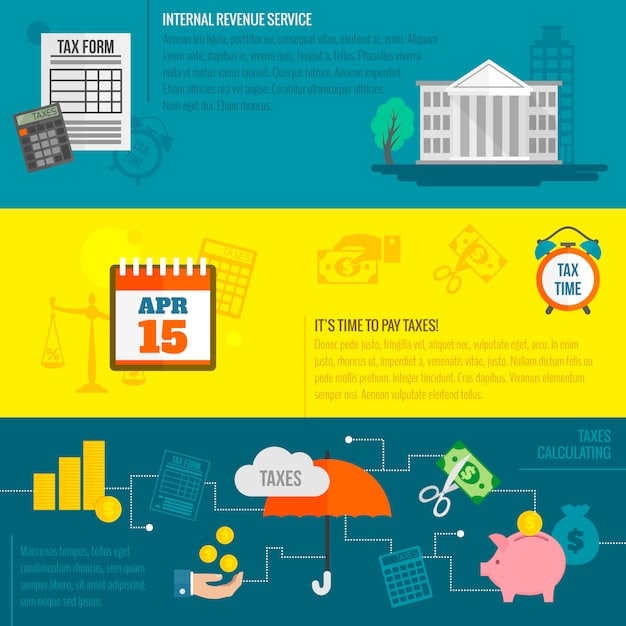Maximize Your Retirement Savings: Tax-Advantaged 401(k)s and IRAs

Maximize your retirement savings by understanding the tax advantages of 401(k)s and IRAs, including pre-tax contributions, tax-deferred growth, and potential Roth options for tax-free withdrawals in retirement.
Planning for retirement can feel overwhelming, especially when navigating the complexities of taxes. Fortunately, 401(k)s and IRAs offer significant tax advantages that can help you maximize your retirement savings: Tax Advantages of 401(k)s and IRAs over time.
Understanding 401(k) Plans and Their Tax Benefits
A 401(k) plan is a retirement savings plan sponsored by an employer. It allows employees to contribute a portion of their salary, often with the employer matching a percentage of the contributions. One of the most appealing aspects of a 401(k) is its tax advantages.
Understanding these tax benefits is crucial for making informed decisions about your retirement savings.
Pre-Tax Contributions
With a traditional 401(k), your contributions are made before taxes are deducted. This means the money you contribute reduces your current taxable income.
Tax-Deferred Growth
The earnings in your 401(k) grow tax-deferred, meaning you don’t pay taxes on the investment gains until you withdraw the money in retirement.

- Lower your taxable income in the present.
- Avoid paying taxes on investment gains during the accumulation phase.
- Potentially grow your wealth faster due to tax deferral.
By taking advantage of these tax benefits, you can significantly increase your retirement savings potential over the long term. This is particularly advantageous for individuals in higher tax brackets.
Exploring Traditional IRAs: Tax Deductions and Growth
Traditional IRAs (Individual Retirement Accounts) offer another avenue for tax-advantaged retirement savings. Unlike 401(k)s, you can open a Traditional IRA regardless of whether your employer offers a retirement plan.
Similar to 401(k)s, Traditional IRAs provide unique tax benefits that can enhance your retirement strategy.
Tax-Deductible Contributions
Contributions to a Traditional IRA might be tax-deductible, depending on your income and whether you’re covered by a retirement plan at work.
Tax-Deferred Growth
Like 401(k)s, earnings within a Traditional IRA grow tax-deferred until you withdraw them in retirement.
Contributing to a Traditional IRA can offer instant tax relief and long-term growth potential.
Roth 401(k)s and Roth IRAs: Tax-Free Withdrawals
Roth accounts, both 401(k)s and IRAs, present a different approach to tax-advantaged retirement savings. Unlike traditional accounts, Roth accounts provide tax-free withdrawals in retirement.
Understanding the mechanics of Roth accounts can help you diversify your tax strategy and maximize your after-tax retirement income.

Tax-Advantaged Growth
While contributions to a Roth 401(k) or Roth IRA are made after-tax, all qualified withdrawals in retirement are tax-free.
Contribution Rules and Limits
Roth accounts have specific contribution rules and income limitations. It’s important to understand these rules to ensure you’re eligible to contribute.
- Tax savings in retirement.
- Versatility in tax planning.
- Potential for future tax benefits.
Carefully consider your current and expected tax situation. If you anticipate being in a higher tax bracket in retirement, a Roth account could prove to be more beneficial.
Maximizing Contributions: Catch-Up Contributions
For those aged 50 and over, the IRS allows for “catch-up” contributions to both 401(k)s and IRAs. This provision enables older savers to contribute above the standard limits.
Understanding the rules and benefits of catch-up contributions is crucial if you’re nearing retirement and want to accelerate your savings.
Catch-Up Contribution Limits
Each year, the IRS sets specific limits for catch-up contributions. These can significantly increase the amount you can save.
Strategic Considerations
Catch-up contributions can be especially beneficial if you started saving late or experienced career disruptions.
Take full advantage of catch-up contributions to give your retirement savings a significant boost. Consult with a financial advisor to determine the optimal strategy for your situation.
Comparing 401(k)s and IRAs: Which is Right for You?
Choosing between a 401(k) and an IRA, or even using both in tandem, depends on your individual circumstances and financial goals. Each offers different advantages and limitations.
Carefully consider the factors that will influence your decision to choose the best retirement fund for you.
Contribution Limits and Employer Matching
401(k)s generally have higher contribution limits than IRAs. Plus, many employers offer matching contributions.
Investment Options and Fees
IRAs often offer a wider array of investment choices, while 401(k)s may have limited options but potentially lower fees due to employer negotiation.
- Consider contribution limits.
- Evaluate investment options.
- Assess fees and expenses.
The decision between a 401(k) and an IRA shouldn’t be an either/or proposition. Utilizing both can provide diversification and tax advantages.
Making the Most of Tax Advantages: Strategic Planning
Maximizing the tax advantages of 401(k)s and IRAs requires careful strategic planning. It’s not just about contributing; it’s about contributing effectively and in alignment with your financial goals.
A comprehensive plan considers your current and future tax bracket, your risk tolerance, and your overall financial objectives.
Asset Allocation and Diversification
A well-diversified portfolio can help mitigate risk and maximize long-term returns, while asset allocation adjusts your portfolio mix to match your goals and risk tolerance.
Regular Review and Adjustments
Tax laws and your financial situation can change, so it’s crucial to review your retirement plan periodically.
Take a proactive approach to retirement planning. Consult with a tax professional or financial advisor to ensure you’re making the most of the tax advantages of 401(k)s and IRAs.
| Key Benefit | Brief Description |
|---|---|
| 💼 Pre-Tax Contributions | Reduces taxable income now with traditional 401(k)s and IRAs. |
| 📈 Tax-Deferred Growth | Earnings grow without annual taxation until withdrawal. |
| 💸 Roth Options | Tax-free withdrawals in retirement with Roth 401(k)s and IRAs. |
| 👵 Catch-Up Contributions | Additional contributions allowed for individuals aged 50 and over. |
Frequently Asked Questions
▼
Traditional 401(k) contributions are pre-tax, reducing your current income. Roth 401(k) contributions are after-tax, but qualified withdrawals in retirement are tax-free.
▼
Contribution limits vary each year and depend on your age. 401(k)s typically have higher limits than IRAs. Check the IRS website for current limits.
▼
Yes, you can contribute to both, if eligible. However, contributing to a Traditional IRA might affect the deductibility of your IRA contributions if you’re covered by a retirement plan at work.
▼
Early withdrawals are generally subject to income tax and a 10% penalty. There are some exceptions, like for certain medical expenses or financial hardships.
▼
Consulting a financial advisor is highly recommended. They can provide personalized advice based on your unique situation and goals to help you maximize your savings.
Conclusion
Understanding and strategically leveraging the tax advantages of 401(k)s and IRAs is essential for maximize your retirement savings: Tax Advantages of 401(k)s and IRAs. By making informed decisions about contributions, account types, and investment strategies, you can build a more secure and comfortable retirement. Consult with a financial advisor to create a retirement plan tailored to your specific needs and goals.





